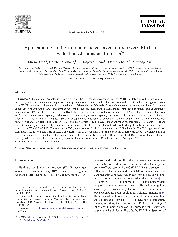摘要
Purpose: Although fluid-attenuated inversion-recovery (FLAIR) magnetic resonance imaging (MRI) is widely applied to diagnose central nervous system diseases, its role in diagnosis of intraspinal tumors is unclear. In this study, we evaluated the potential clinical application of a turbo FLAIR sequence for imaging of intraspinal tumors. Materials and Methods: Forty-eight consecutive patients with intraspinal tumors underwent MRI with turbo FLAIR and turbo spinal echo (TSE) sequences. Turbo FLAIR images were then qualitatively and quantitatively compared with T2-weighted TSE images. Results: Turbo FLAIR images were evaluated as superior to T2-weighted TSE images for image artifact, extradural tumor conspicuity, and intradural extramedullary tumor conspicuity and detection. Intramedullary tumor conspicuity with turbo FLAIR was less than T2-weighted TSE. Similar capabilities in detection of extradural and intramedullary tumors were found between turbo FLAIR and T2-weighted TSE. Turbo FLAIR and T2-weighted TSE displayed similar normal spinal cord signal-noise ratio (SNR) and tumor-to-cerebrospinal fluid (CSF) contrast-to-noise ratio (CNR). In addition, turbo FLAIR yielded significantly higher tumor-to-CSF contrast than T2-weighted TSE. However, tumor SNR, tumor-to-normal spinal cord contrast and CNR with turbo FLAIR images were lower than those with T2-weighted TSE images. Conclusion: This study demonstrated (a) a superiority of turbo FLAIR to T2-weighted TSE in displaying and detecting intradural extramedullary tumors, (b) a superiority of turbo FLAIR to
- 出版日期2008-4
- 单位浙江大学; 杭州医学院
